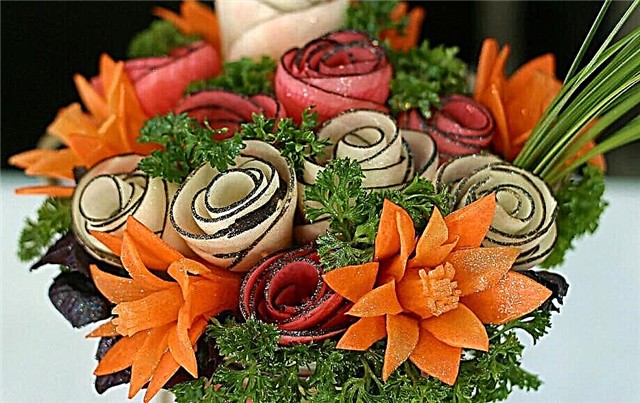Share
Pin
Tweet
Send
Share
Send
Figured cutting of vegetables and fruits - engraving or creating sculptures - will allow you to amaze the guests with your table setting!
True masters of skillful carving from fruits and vegetables appeared in the countries of Southeast Asia in the Middle Ages. In China and Japan, hieroglyphs and images of animals and people were usually cut out using stencils and notches. In Thailand - floral arrangements using knives with very narrow blades and incisors.
Today, looking at the exhibition samples of "culinary carvinists", many would like to repeat their work at home. But we will make a reservation right away - this will not be easy. Firstly, this will require a whole set of special tools, as mentioned above, - knives and cutters of various shapes and sizes, stencils, recesses, scissors (pictured is a set of tools for professional culinary carving).

Secondly, as well as the development of many other types of crafts, the art of carving will have to learn a lot before exhibition masterpieces get out of your hands.
And finally, thirdly, culinary carving at home is, rather, an exciting hobby, especially for families with children.After all, learning the simplest carving techniques is easy enough, and having mastered 5-6 techniques, you can easily set the table no worse than in the banquet room of an expensive restaurant.
And now we’ll try ...
First of all, consider what you have in stockand: sometimes an existing fruit in itself resembles a little animal, and it’s enough to supplement an almost finished natural sculpture with a few well-aimed details, connecting them with toothpicks (see photo).

Then there are a few simple well-known tricks, for example:
ORANGE
Cut off the top of the fetus; take out the flesh; cut the top of the cut peel-cup with cloves (or immediately cut the top with cloves); use the resulting cup as a container for salads.
A PINEAPPLE
Cut the fruit along or across, without touching the leaves; take out the flesh; peel to use as a bowl for a variety of dishes, decorate with leaves.
FRESH CUCUMBER
It is not very thin to cut the skin in the form of a petal or leaf. Give the cut strip a more precise shape. Along the edges make cuts in the shape of denticles. With a small knife with a very sharp and thin blade, make a notch or slot first in the middle along the length of the central vein, then similarly make the veins diagonally to the ends of the cloves.
CARROT
Curly leaves can be cut from carrots; petals, which are then folded into a flower; spirals, which are then twisted in the form of an ice cream tube, and a contrast decoration is inserted inside; and you can cut a variety of figures - fish, crabs, etc.
And so the "openwork bump" is made from carrots:
Cut the carrots into circles.With the help of a curly shape for cutting or with a small knife with a sharp tip from circles, cut flowers with a hole in the middle. String carrot flowers onto a wooden skewer. At the end of the skewer, chop any other suitable decoration, for example, a grape berry or a smooth "tip" of carrots.
TOMATO
The simplest thing: cut the barrels of the fruit in the form of petals and fold a flower from them.
It’s more difficult to make a “rosette”: cut off the base of the tomato, then, without separating from the base, cut off the spiral of the skin, moving the knife back and forth to make denticles. Then carefully lay the spiral on the base in the form of a bud.

And do not forget about thinly sliced, almost transparent slices of fish - magnificent delicate delicate shades of delicate fishnet are made of them.
In general, culinary carving is a great area for applying your imagination and experiments! By the way, do not forget to use the "trim" for cooking delicious dishes.
Photo: PR.
Material prepared by Elena Karpova
Share
Pin
Tweet
Send
Share
Send














